Content is from Kirkbride et al. 2006Kirkbride et al. 2006:
Kirkbride JH, Jr, Gunn CR, and Dallwitz MJ. 2006. Family guide for fruits and seeds, vers. 1.0. Accessed September 2020-January 2022. URL: https://nt.ars-grin.gov/seedsfruits/keys/frsdfam/index.cfm ., without modification.
Updates are forthcoming.
Fruits: Pistil(s) compound; 1; 1-pistillate; with carpels united. Fruit pericarpium; simple; capsulecapsule:
a dry, dehiscent fruit derived from a compound ovary ; septifragalseptifragal:
; septifragalseptifragal:
type of capsular dehiscence, splitting through the exterior wall suture(s) but not the septum(-a), the valves of the wall then separating from the septum(-a) and the locules thus opened directly to the outside
capsulecapsule:
a dry, dehiscent fruit derived from a compound ovary (Spjut), or loculicidalloculicidal:
(Spjut), or loculicidalloculicidal:
type of capsular dehiscence, opening longitudinally through the locules (compare septicidal)
 capsulecapsule:
capsulecapsule:
a dry, dehiscent fruit derived from a compound ovary (of authors, not Spjut); capsulecapsule:
(of authors, not Spjut); capsulecapsule:
a dry, dehiscent fruit derived from a compound ovary not inflated; capsulecapsule:
not inflated; capsulecapsule:
a dry, dehiscent fruit derived from a compound ovary without operculumoperculum:
without operculumoperculum:
a dehiscent cap (or lid) of a seed or fruit that opens during germination or dehiscence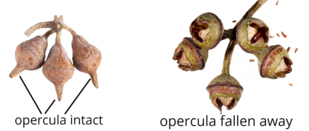 ; with persistent central column; valves not diverging at top of central column; not within accessory organ(s); 10 to less than 25-seeded; many; with 3-carpellate; with carpels united; without sterilesterile:
; with persistent central column; valves not diverging at top of central column; not within accessory organ(s); 10 to less than 25-seeded; many; with 3-carpellate; with carpels united; without sterilesterile:
lacking male and/or female reproductive parts; also, not producing fruit or seed
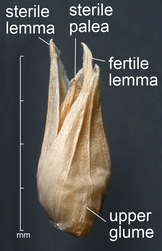 carpels; not sulcatesulcate:
carpels; not sulcatesulcate:
surface relief—having one or more elongate, relatively narrow and shallow depressions or grooves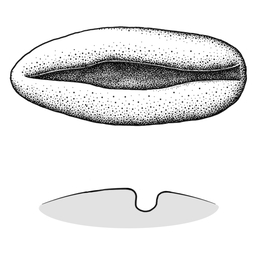 ; apexapex:
; apexapex:
the point farthest from the point of attachment, or the "tip" of an organ not beaked; dehiscentdehiscent:
not beaked; dehiscentdehiscent:
(v. dehisce) splitting open at maturity to release contents (of a fruit)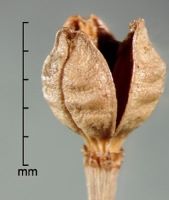 . Dehiscentdehiscent:
. Dehiscentdehiscent:
(v. dehisce) splitting open at maturity to release contents (of a fruit) unit seed(s). Dehiscentdehiscent:
unit seed(s). Dehiscentdehiscent:
(v. dehisce) splitting open at maturity to release contents (of a fruit) regularly; and shedding seeds; without replumreplum:
regularly; and shedding seeds; without replumreplum:
the rim, formed by the persistent placentas, and connected by a false septum in Brassicaceae fruits. The fruit valves are attached to this rim and separate from it in dehiscent fruits.
. Epicarpepicarp:
outer layer of fruit wall or pericarp, if divided into layers; note here used synonymously with exocarp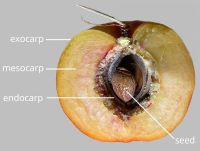 durable; without armature; not smooth; tuberculatetuberculate:
durable; without armature; not smooth; tuberculatetuberculate:
surface relief—bearing small, warty, swelling, rounded, or variously shaped projections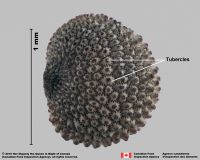 , or verrucoseverrucose:
, or verrucoseverrucose:
surface relief—warty, covered with wart-like projections
; without wing(s); without apicalapical:
at or pertaining to the end of the seed or fruit distal from its point of attachment (i.e., base)
respiratory hole. Endocarpendocarp:
the inner layer of the pericarp, if divided into layers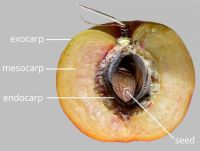 present; not separating from exocarpexocarp:
present; not separating from exocarpexocarp:
outer layer of fruit wall or pericarp, if divided into layers; note here used synonymously with epicarp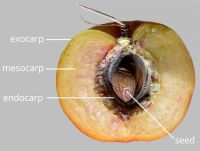 ; thin; not splitting into 1-seeded pyrenes; smooth; without wing; without operculumoperculum:
; thin; not splitting into 1-seeded pyrenes; smooth; without wing; without operculumoperculum:
a dehiscent cap (or lid) of a seed or fruit that opens during germination or dehiscence ; without secretory cavities; without grooves; without longitudinallongitudinal:
; without secretory cavities; without grooves; without longitudinallongitudinal:
of or relating to length or the lengthwise dimension
ridges. Funiculusfuniculus:
(alt. funicle) stalk connecting the ovule (later seed) to the ovary (later fruit) placenta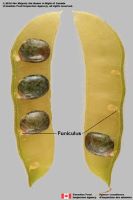 short; short without seed bearing hookswith hooks:
short; short without seed bearing hookswith hooks:
bristles or spines with curved or backwards pointing tips, or with secondary bristles along their length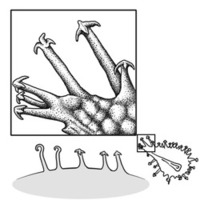 (retinacula); not persisting in fruit after seed shed.
(retinacula); not persisting in fruit after seed shed.
Seeds:Arilaril:
(broad sense) appendicular structure that wholly or partly envelops a seed and is produced from or a modification of the funicle, raphe, or outer integument; usually fleshy or pulpy, sometimes spongy or tufted-capillate, often brightly colored absent. Seed minute; not bowl shaped; not nutlike; without winglike beakbeak:
absent. Seed minute; not bowl shaped; not nutlike; without winglike beakbeak:
a usually firm, terminal appendage, sometimes tapered ; without caudatecaudate:
; without caudatecaudate:
tapering to a long, tail-like appendage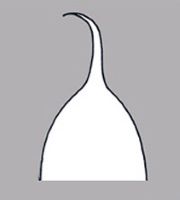 appendage(s); at maturity with food reserves; with endosperm; without canavanine. Sarcotestasarcotesta:
appendage(s); at maturity with food reserves; with endosperm; without canavanine. Sarcotestasarcotesta:
pulpy or fleshy outer layer of the seed coat, simulates aril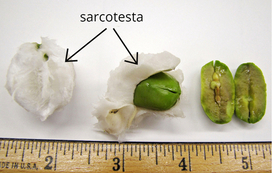 absent. Testatesta:
absent. Testatesta:
seed coat
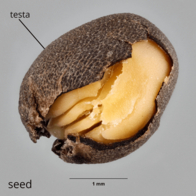 present; without fleshy or leatheryleathery:
present; without fleshy or leatheryleathery:
texture—moderately thick, tough, and very pliable
layer over hard layer; surface unsmooth; surface with merged raised features; surface reticulatereticulate:
surface relief—netted, raised walls or concave grooves forming a net-like surface pattern with flat, concave, or convex interspaces ; without crease or line separating cotyledons from hypocotyl-radicle; without notch along margin where cotyledons from hypocotyl-radicle tip approach each other; without glands; without bristles; with wing(s), or without wings (seldom); 2-winged; with wings on both sides; without collar; without operculumoperculum:
; without crease or line separating cotyledons from hypocotyl-radicle; without notch along margin where cotyledons from hypocotyl-radicle tip approach each other; without glands; without bristles; with wing(s), or without wings (seldom); 2-winged; with wings on both sides; without collar; without operculumoperculum:
a dehiscent cap (or lid) of a seed or fruit that opens during germination or dehiscence ; colored; monochrome; thin (single cell layer); not becoming mucilaginousmucilaginous:
; colored; monochrome; thin (single cell layer); not becoming mucilaginousmucilaginous:
resembling mucilage; moist and sticky
when wetted; surrounding food reserve. Endosperm development cellular; moderate (copious according to Mabberley); fleshy; smooth; with oils; without fatty acid containing cyclopropene; without apicalapical:
at or pertaining to the end of the seed or fruit distal from its point of attachment (i.e., base)
lobes; without chlorophyll; without isodiametric faceted surface; without odor. Embryo differentiated from food reserve; well developed; 1 per seed; partially filling testatesta:
seed coat
 (with food reserve); 0.9 times the length of food reserve; at one end of seed not extending into a depression or cup; axileaxile:
(with food reserve); 0.9 times the length of food reserve; at one end of seed not extending into a depression or cup; axileaxile:
on or of the axis
and centric; linearlinear:
(shape) long, narrow, and uniform in width; (of embryo) embryo is straight and much longer than wide ; straight; parallel to seed length; with cotyledons abruptly connected to hypocotyl-radicle; without coleorhiza; without simmondsin; without stomata; not green; with 2 or more cotyledons. Cotyledons 2; well developed; 0.25 times length of embryo; somewhat to significantly wider than hypocotyl-radicle; smooth; with apicesapex:
; straight; parallel to seed length; with cotyledons abruptly connected to hypocotyl-radicle; without coleorhiza; without simmondsin; without stomata; not green; with 2 or more cotyledons. Cotyledons 2; well developed; 0.25 times length of embryo; somewhat to significantly wider than hypocotyl-radicle; smooth; with apicesapex:
the point farthest from the point of attachment, or the "tip" of an organ entire; with margins separate; basally cordatecordate:
entire; with margins separate; basally cordatecordate:
2D shape—heart-shaped, with attachment at or near the broad end (compare obcordate)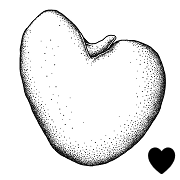 (more or less); equal in size; not punctatepunctate:
(more or less); equal in size; not punctatepunctate:
surface relief—dotted with pits or with translucent, sunken glands or with colored dots, similar to pitted dotted. Hypocotyl-radicle moderately developed; coiledcoiled:
dotted. Hypocotyl-radicle moderately developed; coiledcoiled:
(of embryo) linear embryo is very long and bent to form a coil whereby one end of the embryo is on the outside and the other end near the middle of the seed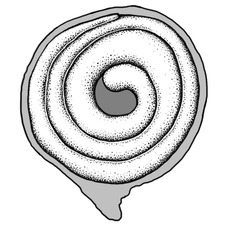 ; not thickened.
; not thickened.
 because of "incompletely opening along the dorsaldorsal:
because of "incompletely opening along the dorsaldorsal: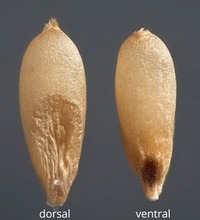 or ventralventral:
or ventralventral: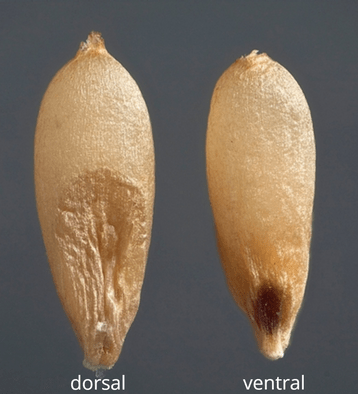 sutures by break in partitions near central axisaxis:
sutures by break in partitions near central axisaxis:Literature specific to this family: Fernald, M.L. 1950. Gray's Manual of Botany, 8th Ed., 1,632 p. American Book Co., New York.
General references: Cronquist, A. 1981. An integrated system of classification of flowering plants, 1,262 p. Columbia University Press, New York, Engler, A. & K. Prantl. 1924 and onward. Die Natürlichen Pflanzenfamilimien. W. Engelman, Leipzig, Gaertner, J. 1788–1805. De fructibus et seminibus plantarum. The Author, Stuttgart, Goldberg, A. 1986 (dicots) & 1989 (monocots). Classification, evolution, and phylogeny of the familes of Dicotyledons. Smithsonian Contr. Bot. 58 for dicots (314 pp.) & 71 for monocots (74 pp.). [Goldberg's illustrations are reproduced from older publications and these should be consulted], Gunn, C.R., J.H. Wiersema, C.A. Ritchie, & J.H. Kirkbride, Jr. 1992 & amendments. Families and genera of Spermatophytes recognized by the Agricultural Research Service. Techn. Bull. U.S.D.A. 1796:1–500, and Spjut, R.W. 1994. A systematic treatment of fruit types. Mem. New York Bot. Gard. 70:1–182.